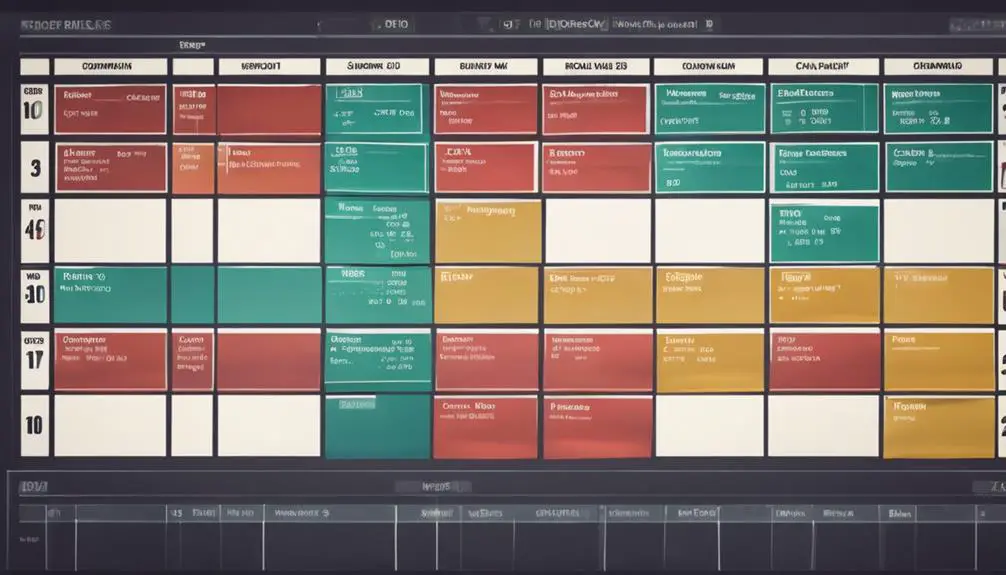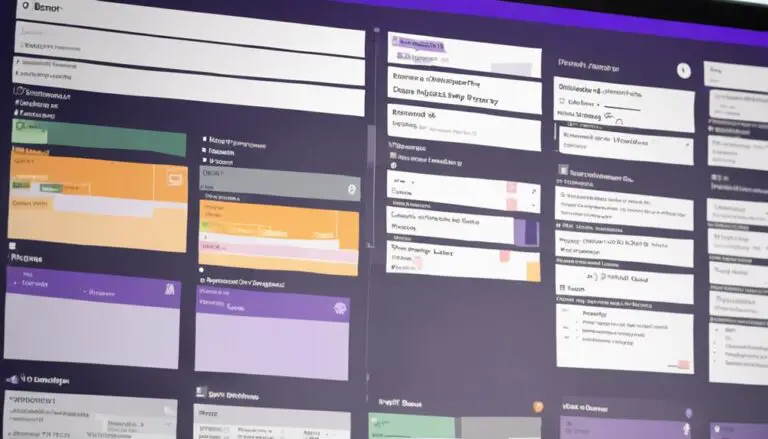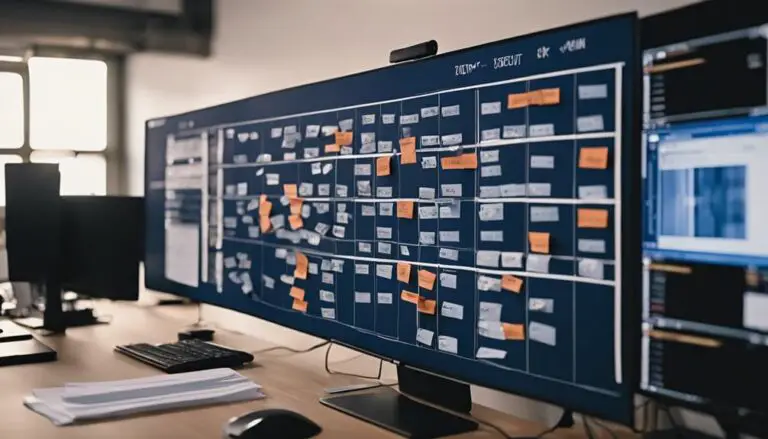When navigating the intricate pathways of project management, like a navigator charting uncharted waters, the ability to track percentage completion inferred from a Kanban board can serve as a compass, guiding your team towards successful project outcomes.
Imagine the efficiency gained from understanding the nuances of progress within each task phase, all at a glance. This method offers a strategic advantage in project planning and execution, but how exactly does this nuanced tracking translate into tangible results for your team?
Let's explore how this approach can revolutionize your project management strategies.
Key Takeaways
- Estimate completion percentage by comparing completed tasks to total tasks accurately.
- Utilize Kanban metrics for better visibility into task progression.
- Enhance productivity by identifying and resolving workflow bottlenecks effectively.
- Make data-driven decisions for continuous improvement and optimized workflow efficiency.
Understanding Kanban Board Workflow
To grasp the essence of Kanban board workflow, focus on its fundamental purpose: visualizing task progression and work item flow within Scrum teams. Using Kanban involves organizing tasks into columns representing various stages of completion, such as 'To Do,' 'In Progress,' and 'Done.' This visual representation allows team members to see the status of each task at a glance and understand how work items are flowing through the system. By limiting the number of tasks allowed in the 'In Progress' column, Kanban helps teams maintain focus and avoid overloading themselves with work.
Kanban boards also incorporate signals like color-coded cards or tags to indicate task priority or type, making it easier for team members to prioritize their work. Additionally, the use of swimlanes can further categorize tasks based on different criteria, providing even more clarity on task status and ownership. By effectively utilizing Kanban boards, Scrum teams can streamline their workflow, improve communication, and enhance overall productivity.
Interpreting Task Status on Kanban
When interpreting task status on a Kanban board, focus on:
- Task progress visualization
- Work item categorization
These points offer valuable insights into how work is moving through your workflow and the current status of each task.
Task Progress Visualization
Understanding how to interpret task status on a Kanban board through task progress visualization is essential for effectively managing workflow and tracking progress. The movement of cards across columns visually indicates the stage of completion within the workflow.
Each column represents a specific phase of work, allowing you to see at a glance where tasks stand in the process. By tracking task movement on the board, you gain a clear understanding of progress and can efficiently manage work.
This visual representation not only helps in organizing tasks but also provides a sense of accomplishment as you see tasks moving through the workflow stages. Embracing this visual method enhances your ability to monitor and control the workflow effectively.
Work Item Categorization
Categorizing work items on a Kanban board involves assigning tasks to specific columns that represent different stages of completion. Each column, such as 'To Do,' 'In Progress,' 'Testing,' or 'Done,' signifies a specific status or phase of the task. This categorization aids in visualizing task progress and pinpointing any bottlenecks or delays in the workflow.
As tasks move across columns, the flow of work becomes apparent, offering valuable insights into the project's overall status. Understanding the meanings behind each column in the Kanban board is essential for effectively tracking and managing task completion.
Calculating Percentage of Completion
To determine the overall completion percentage when using a Kanban board, you may need to incorporate supplementary tracking methods or tools alongside the visual workflow system. Since Kanban boards primarily focus on visualizing task flow and work items rather than providing a direct measure of completion percentage, calculating this metric can be challenging. One way to address this challenge is to implement a supplementary tracking tool that can provide a more quantitative measure of completion, such as a digital task management system or a project management software. Additionally, incorporating the kanban sprint process, which involves setting specific time-bound goals for completing tasks, can also help in determining the overall completion percentage and improving team efficiency. By combining the visual workflow system of a Kanban board with these supplementary methods, teams can gain a more comprehensive understanding of their project progress and make informed decisions for continuous improvement.
One approach to estimating completion percentage involves considering the number of tasks completed compared to the total tasks in the workflow. By also tracking work in progress, you can gain a better understanding of how close the team is to finishing all items on the board.
Integrating additional tools that allow for quantifying completed tasks and visualizing the overall progress can enhance the accuracy of your completion percentage calculations. While Kanban boards excel at illustrating workflow and task movement, supplementing them with complementary tracking mechanisms can help you derive a more comprehensive view of the team's progress towards completing all tasks.
Importance of Data-Driven Decisions
For effective project management, rely on accurate and timely data from metrics like lead time, cycle time, and throughput to make informed decisions. When you, as a project manager, prioritize data-driven decision-making, you enhance the efficiency and effectiveness of your team's workflow.
Here are four reasons why data-driven decisions are crucial for successful project management:
- Improved Forecasting: By analyzing lead time metrics, you can accurately predict task completion times, aiding in resource allocation and scheduling.
- Enhanced Productivity: Utilizing Kanban metrics such as Work in Progress (WIP) and queues allows you to identify bottlenecks promptly, enabling you to optimize workflow efficiency.
- Continuous Improvement: Tracking and analyzing Kanban metrics provide insights for making necessary adjustments, prioritizing tasks effectively, and fostering a culture of continuous improvement.
- Optimized Decision-Making: Kanban boards offer visibility into task progress, enabling you to make informed decisions based on real-time data, ultimately leading to better project outcomes.
Enhancing Productivity Through Insights
Enhancing productivity through insights starts with leveraging Kanban metrics to optimize workflow efficiency and foster continuous improvement. While Kanban boards in Scrum teams may not directly display percentage completion, customizing tracking mechanisms can enhance visibility into task completion levels.
Tools like Structure for Jira offer advanced features for visualizing workflows and tracking task completion percentages within Kanban phases. By utilizing custom fields or tools like Structure for Jira, teams can effectively track progress percentages and enhance productivity.
Community insights also recommend using custom fields and workflow postfunctions to ensure efficient progress tracking on Kanban boards. These insights provide valuable guidance for teams looking to streamline their processes and improve productivity by gaining deeper insights into their workflow progress on the Kanban board.
Optimizing Delivery Timelines With Kanban
Optimize delivery timelines with Kanban by visualizing work progress and identifying bottlenecks to enhance efficiency and on-time task completion. By leveraging Kanban principles, you can streamline your workflow and ensure timely delivery.
Here's how you can do it effectively:
- Visualize Workflow: Use a Kanban board to create a flow diagram that displays the stages of your project, from start to finish.
- Identify Bottlenecks: Monitor your Kanban board to pinpoint areas where tasks tend to get stuck, and focus on resolving these bottlenecks promptly.
- Track Cycle Time: Measure the time it takes for a task to move from start to finish, helping you predict and optimize delivery timelines.
- Set WIP Limits: Establishing Work In Progress limits on your Kanban board ensures that team members focus on completing tasks efficiently, avoiding overload and delays.
Leveraging Kanban for Progress Tracking
When leveraging Kanban for progress tracking, visualizing work progress becomes essential for optimizing workflow efficiency. By assigning percentages to Kanban board columns, you can gain a clearer overview of task completion progress and identify bottlenecks more effectively.
Customized tracking mechanisms and tools like Structure for Jira can enhance visibility into task progress within each phase of the Kanban board, streamlining tracking processes and improving team collaboration.
Visualizing Work Progress
To effectively track progress on your Kanban board, visualize work progress by utilizing its features to monitor task flow and work items within your team.
Here are four ways to effectively visualize work progress using the Kanban board:
- Utilize Swimlanes: Divide tasks into categories to show progress within different stages or teams.
- Color Code Cards: Assign colors to tasks based on priority or status to quickly identify progress.
- Use Task Dependencies: Link related tasks to show how progress on one task impacts others.
- Update Task Status: Regularly move tasks across columns to reflect their current stage and provide a real-time view of progress.
Optimizing Workflow Efficiency
Enhancing workflow efficiency through strategic utilization of Kanban boards for progress tracking is crucial for maximizing productivity and collaboration within teams. Kanban boards offer a visual representation of tasks moving through different stages.
To enhance efficiency, incorporating progress percentages can provide a clearer picture of task completion. Tools like Structure for Jira enable teams to assign and track progress percentages within Kanban board columns, improving visibility and collaboration.
Leveraging features such as Structure for Jira's Progression virtual field can aid in monitoring progress more effectively. By customizing tracking mechanisms within Kanban boards, teams can optimize workflow efficiency, leading to better coordination and ultimately, improved project outcomes.
Frequently Asked Questions
Does Kanban Board Show Percentage Completion?
Kanban efficiency is about visualizing workflow, not showing percentage completion. To improve tracking, consider using custom fields or tools like Structure for Jira. You can enhance progress monitoring within phases for a more accurate overview.
How Do I Track My Progress on Kanban?
Track your progress on a Kanban board by focusing on progress visualization. Use visual cues like task movement and work in progress limits. Avoid relying solely on percentage completion from the board; consider custom fields or tools for accurate tracking.
When Tracking a Team Progress What Can a Kanban Board Show the Team?
When tracking a team's progress, a Kanban board can show the flow of work items through stages, highlight limits on work in progress, and aid in maintaining focus. It enhances team engagement by visualizing tasks and workflows.
What Are the KPI Metrics for Kanban?
When analyzing KPIs for Kanban, focus on Lead Time, Cycle Time, Throughput, Work in Progress (WIP), and Queues. These metrics offer insights into task efficiency, team productivity, and workflow optimization, aiding in managing processes effectively.
Conclusion
As you navigate the winding road of project management, remember that tracking percentage completion from your Kanban board is like having a GPS for your tasks. It helps you stay on course, avoid detours, and reach your destination efficiently.
With this tool in hand, you can steer your team towards success, making informed decisions and optimizing productivity along the way.
So buckle up, keep an eye on that percentage, and enjoy the smooth ride to project completion!





